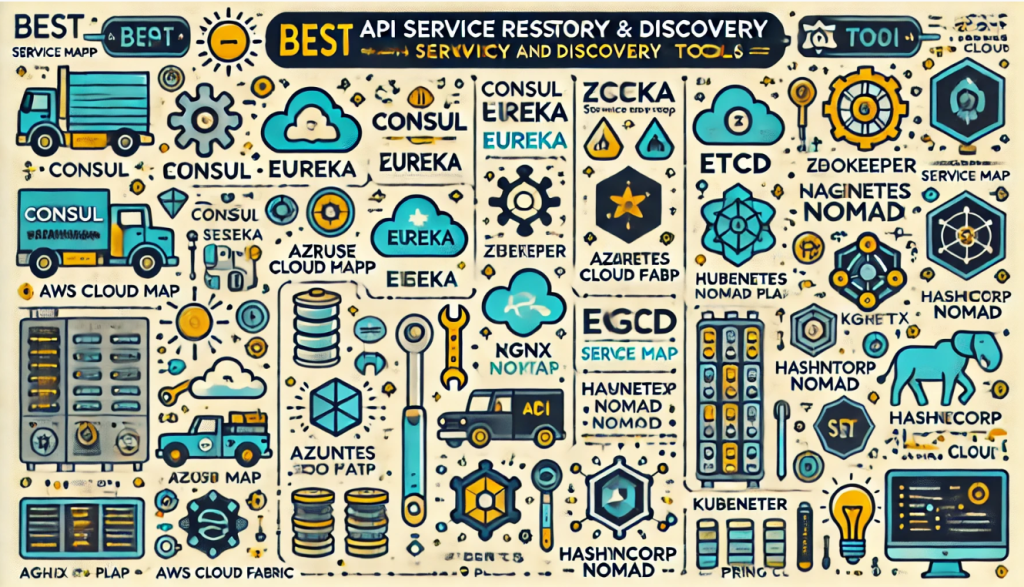
In the world of microservices, API service registry and discovery are fundamental concepts that ensure efficient communication and coordination between different services. Imagine a large office building with numerous departments. A service registry acts like a directory listing the departments (services) and their locations (endpoints), while service discovery is the process of finding the specific department you need (service) based on its function.
Here’s a breakdown of how they work together:
API Service Registry:
- Acts as a central database that stores information about all the available microservices within a distributed system.
- Each service registers itself with the registry, providing details like:
- Service name or ID
- Network location (IP address, port number)
- Functionality or purpose of the service
- Health status (whether the service is up and running)
- Additional metadata (version information, security credentials)
- This registry essentially becomes a single source of truth for all service information.
API Service Discovery:
- When a microservice needs to interact with another service, it queries the service registry to find the location of the target service.
- The discovery process typically involves:
- Service client searching the registry based on service name, functionality, or other criteria.
- Registry returning the details of the appropriate service instance(s).
- Service client using the retrieved information to connect and communicate with the target service.
Benefits of API Service Registry & Discovery:
- Dynamic Service Management: Services can be added, removed, or updated dynamically without affecting other services. The registry reflects these changes, ensuring service discovery remains accurate.
- Improved Scalability: As the number of microservices grows, the registry and discovery mechanism help manage communication efficiently.
- Loose Coupling: Services are loosely coupled, meaning they don’t need to know the exact location of other services beforehand. They rely on the registry for discovery.
- Simplified Development: Developers don’t need to hardcode service locations in their code. They can leverage discovery to find the necessary services at runtime.
- Improved Fault Tolerance: If a service becomes unavailable, the discovery process can identify healthy alternatives within the registry.
Here are some of the best API service registry and discovery tools that help in managing, discovering, and integrating microservices effectively:
1. Consul by HashiCorp
- Overview: A service mesh solution providing a full-featured service discovery and configuration system.
- Features:
- Service discovery and health checking
- Key-value storage for configuration
- Secure service communication with mTLS
- Multi-datacenter support
- Website: Consul
2. Eureka by Netflix
- Overview: A REST-based service used for locating services for the purpose of load balancing and failover of middle-tier servers.
- Features:
- Service registry and discovery
- Instance registration and renewal
- Client-side load balancing (via Ribbon)
- Integrates with Spring Cloud Netflix
- Website: Eureka
3. Apache Zookeeper
- Overview: A centralized service for maintaining configuration information, naming, providing distributed synchronization, and providing group services.
- Features:
- High availability and reliability
- Hierarchical namespace
- Efficient, scalable performance
- Coordination for distributed systems
- Website: Apache Zookeeper
4. Kubernetes
- Overview: An open-source platform for automating deployment, scaling, and operations of application containers across clusters of hosts.
- Features:
- Built-in service discovery
- Load balancing and DNS integration
- Automated deployment and scaling
- Self-healing capabilities
- Website: Kubernetes
5. AWS Cloud Map
- Overview: A service discovery solution that allows you to map cloud resources.
- Features:
- Service discovery and registry
- Automatic health checking
- Integrated with AWS services
- DNS and API-based discovery
- Website: AWS Cloud Map
6. Istio
- Overview: An open-source service mesh that layers transparently onto existing distributed applications.
- Features:
- Service discovery and load balancing
- Traffic management and security
- Observability and telemetry
- Policy enforcement
- Website: Istio
7. Open Service Mesh (OSM)
- Overview: A lightweight and extensible cloud-native service mesh.
- Features:
- Service discovery and traffic management
- Security features including mTLS
- Observability and metrics collection
- Integrates with Kubernetes and other CNCF projects
- Website: Open Service Mesh
8. Nacos by Alibaba
- Overview: An easy-to-use platform designed for dynamic service discovery, configuration, and service management.
- Features:
- Service discovery and health checking
- Dynamic DNS service
- Configuration management
- Supports Dubbo, Spring Cloud, and Kubernetes
- Website: Nacos
9. Spring Cloud
- Overview: Provides tools for developers to quickly build some of the common patterns in distributed systems.
- Features:
- Service discovery (using Eureka, Consul, Zookeeper)
- Distributed configuration
- Intelligent routing and load balancing
- Service-to-service calls
- Website: Spring Cloud
10. Traefik
- Overview: A modern HTTP reverse proxy and load balancer made to deploy microservices with ease.
- Features:
- Dynamic service discovery
- Automatic HTTPS
- Extensive middleware support
- Load balancing and health checking
- Website: Traefik
I’m a DevOps/SRE/DevSecOps/Cloud Expert passionate about sharing knowledge and experiences. I am working at Cotocus. I blog tech insights at DevOps School, travel stories at Holiday Landmark, stock market tips at Stocks Mantra, health and fitness guidance at My Medic Plus, product reviews at I reviewed , and SEO strategies at Wizbrand.
Do you want to learn Quantum Computing?
Please find my social handles as below;
Rajesh Kumar Personal Website
Rajesh Kumar at YOUTUBE
Rajesh Kumar at INSTAGRAM
Rajesh Kumar at X
Rajesh Kumar at FACEBOOK
Rajesh Kumar at LINKEDIN
Rajesh Kumar at PINTEREST
Rajesh Kumar at QUORA
Rajesh Kumar at WIZBRAND

